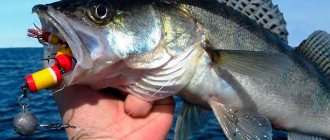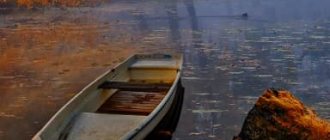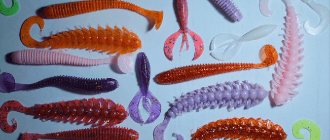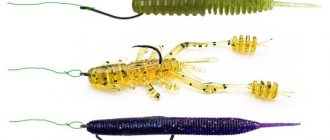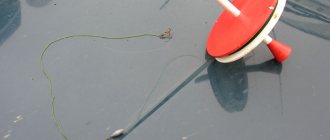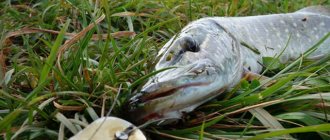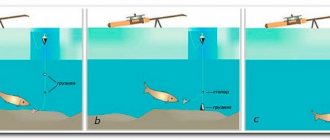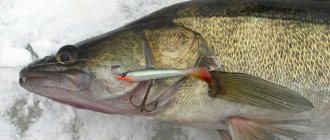Mandula is one of the most effective baits. Most often it is used for jig fishing. Mandula is suitable for catching predatory fish, such as perch, pike, salmon.
Mandula has the following set of advantages:
- Catchability. Mandula has phenomenal catchability. But the fisherman must have the right gear and know about fishing techniques.
- Versatility. Can be used to catch a variety of fish. You can go fishing in any weather.
- Modifications. Fishing stores offer a wide range of models. Each model has individual characteristics and sizes. There are models that are suitable for a specific fishing location.
- Colors. Various colors available. Red and green baits are very popular.
- Design. The design is very simple and reliable. Therefore, you can make the bait yourself. This will require a standard set of tools and materials.
Mandula is a classic bait. It has high efficiency and catchability. Therefore, it is often used by professional fishermen. Most often it is used for catching pike perch. Pike perch is a cunning and active fish.
To catch a large specimen (5–10 kg), you need to use a large bait.
The main advantage of this bait is its simple design. The design consists of only a few elements. Body parts are made from various materials. Polyurethane foam has high wear-resistant properties. Therefore, it is often used to make body parts.
Rings and wire are used as connecting elements. And the quality is a lead head and tees are installed. The bait demonstrates catchability when fishing on the slope between the upper and lower coastal edges.
The disadvantage of this bait is that it gets snagged. But snags can be avoided. To do this you need to make sharp jerks.
The bait can be used for fishing in places with current. The predator's favorite habitat is coastal edges. Here you can catch a large specimen.
Catching a predator with a mandula
The world of predatory fish is diverse. But they all have one thing in common: nutrition. Predatory fish feeds on small fish. Therefore, the bait imitates a small fish.
Mandula can be used to catch the following predatory fish:
- perch;
- salmon;
- pike;
- pike perch, etc.
The predator can be found where small fish gather. First of all, these are areas with slow currents. This is the favorite habitat of the predator. And it is also necessary to pay attention to the turns of the riverbed. Small fish most often gather in these places. This means there is a predator lurking somewhere nearby.
Fishing success depends on the right bait. Green bait is suitable for salmon. And for perch, a black mandula is suitable. But you need to take weather conditions into account. In the evening and at night, give preference to light-colored baits. Whereas in the morning you need to use a dark-colored mandula.
Experts recommend using light jerks as well as smooth wiring. This is the perfect combination. The fisherman must go around all the edges that are located along the coastline. Otherwise, snags may occur.
And it is also necessary to pass by snags and rubble. You need to cast to greater depths.
Catching pike perch with a mandula
Pike perch is a relative of perch. He prefers to live in clean waters and does not like heat. Therefore, in summer it is better to fish in cloudy weather. The favorite habitats of such fish are snags and cluttered places.
What kind of wiring is used when fishing for pike perch?
- Dragging along the bottom. This type of wiring is a jig. In this case, the fisherman must experiment with the duration of pauses and the speed of the retrieve. As a rule, the bite occurs at the moment of stopping. When using such wiring, the bait plays with its tail and also raises the turbidity. This behavior attracts pike perch.
- Stepped. This is a popular bait when fishing for pike perch. This wiring can be done in two ways (reel, rod). Most often, stepwise wiring is carried out using a coil. When retrieving in steps, it is necessary to slow down the movement of the bait. This can be done in two ways (nods or pauses).
- Throwing tactics. You can do a series of tosses. And after 3-4 tosses you need to pause.
Let's take a closer look at the wire drawing along the bottom:
- First you need to choose the right fishing spot. The pond must have a clean bottom. This is the main requirement when choosing a fishing location.
- The fisherman must guide the bait along the bottom. No need to make sudden movements.
- At the right moment you need to pause (5-10 seconds).
- After that, you need to continue playing.
Fishing technique:
- This bait should be used for fishing in clean waters.
- To find pike perch, you need to fish the most promising places.
- Better animation can be achieved on the current. First you need to fish the coastal edges.
Catching pike with a mandula
Pike is a predatory fish. It lives in freshwater bodies of water. To catch such fish, you can use various baits, including mandula.
Pike attacks almost any bait. Therefore, you can use homemade baits. It is best to use brightly colored mandula for fishing. Give preference to large size models (8–12 centimeters). And to catch big fish you will need a bait more than 13 cm long.
What kind of wiring is used when fishing for pike?
- uniform;
- jerk;
- stepped.
Any wiring can be used. But you need to take into account weather conditions, fishing location, etc. In the summer, high-speed fishing is used. In this case, the fisherman needs to take frequent breaks.
And when fishing from a boat, vertical wiring is used. The fisherman must make jerks of varying amplitudes. As a rule, the bite occurs on the rise, as well as on the fall.
Catching salmon with a mandula
Salmon is a large fish (up to 39 kg). Such fish are born in fresh water. And then she moves to salty bodies of water.
The mandula imitates the movement of a small fish. Thus attracts the attention of a predator. This is an excellent option for jig fishing with a spinning rod.
Salmon often attacks the bait as it falls. In this case, the fisherman must make small jerks. This creates vibration. This behavior of the bait provokes the salmon to attack.
Experts recommend using light jerks and smooth retrieves when fishing for salmon. And the cast needs to be done to great depth.
Where to look for fish?
- vertical lifts;
- longitudinal pits;
- vertical descents;
- coastal edges;
- at the bends of the riverbed.
When fishing in still water, it is necessary to overload the mandula. The bait will oscillate.
Catching perch with a mandula
Perch is a freshwater fish. It lives in lowland reservoirs.
To catch perch, baits with a length of 3 to 6 cm are used. And baits with two and three segments are also used.
To catch such fish, light and ultralight rods are often used. Such fishing rods can withstand a lot of weight. And you will also need weights weighing up to 13 grams.
The best time to catch perch is evening and morning. In the summer, perch is most active, so it attacks any bait. As a rule, perch lives along the coastal trunk, as well as behind coastal vegetation.
How to catch perch correctly?
- First you need to choose the right fishing spot. The most bites will be on reservoirs that have an overgrown or snagy bottom.
- Now you need to throw the mandula. It's better to make a long cast.
- After this, the fisherman must conduct a slow retrieve . In total, you need to make 4–6 even wiring. In this case, you cannot twitch.
Hooks
Hooks for equipping a mandula must be sharp, durable, easy to dull, lightweight... and cheap. Since such hooks do not yet exist in nature, I use mandules with different hooks for different fishing conditions. I’ll say right away that I’ve apparently given up cheap, low-quality Chinese hooks forever. We don’t go fishing for half a day to look for a predator, find it, tempt it to bite, and with complete disappointment drop it at our very feet because of a low-quality but cheap hook. It is much better to enjoy a good bite, a reliable hook, pleasant fishing and, if you want, a feeling of satisfaction when releasing the fish into its native element. Therefore, I try to use either high-quality hooks or medium-quality hooks.
There is an opinion that the mandula is an extremely expensive bait, so many fishermen try to save on hooks by using cheaper tees. It really is a very expendable bait if you don’t think about how to properly use its potential. What does this mean? Firstly, it is not justified to use a mandula for all occasions. It, like any other bait, has its limitations in use and does not always work for a specific predator at one time or another of the year. Secondly, you need to correctly select the design of the mandula for certain fishing conditions. For example, it is illogical to use a classic two-hook mandula when searching widely for predators in unknown waters and in “strong” places. In this case, it is better to use a mandula with one hook - triple, double or single in a non-hooking version. And thirdly, to minimize the loss of bait, you can use certain tactics for fishing a particular place. Let's say a fisherman using an echo sounder arrived at an unknown place, but promising in terms of the bottom topography. If he intends to fish with a mandula, then it is advisable to carry out the first movements with a mandula with a single hook in a non-hooking version, and then, after the place is more or less checked for the presence of hooks, use a mandula with one double or triple hook or a classic two-hook bait. You can also preliminarily “check” an unknown place with another passive bait - foam rubber with pressed doubles.
Based on grip, both in relation to fish and in relation to snags, bottom trash, stones, etc., I arranged the mandula designs in the following approximate row. Approximate because some individual positions in it are close and practically interchangeable, for example, the 3rd and 4th from the top.

The first from the top, the most hooky group of three mandules is double-hooked using a front tee, the second most hooky group of three mandules is double-hooked using a front double, and then follow the single-hook designs - using a tee, a double and a single non-hooking one. With the help of this series, a homemade fisherman will be able to approximately assess the potential of his future creation.
At first glance, looking at the row, we can say that this is a banal selection of types of hooks - triple, double, single. In fact, everything is far from the case and each hook plays a specific role.
The use of front tees ensures maximum catchability of the bait, which is especially valuable during external contacts with weakly active fish. Please do not confuse it with purpleness. Any practicing angler has found himself in a situation where the fish is in such a state that it simply presses the bait from above, getting caught by the “tie.”
The use of front doubles significantly reduces the hookiness of the bait, while the hooking ability does not suffer much. The tips of the front hooks facing upwards remain in good condition longer
The use of rear tees is for passive fish interested in the miracle tip of the bait.
The use of rear doubles and singles is for straightening the mandula, when you need to make it as visible as possible against the bottom with uneven terrain and when fishing in a current that “tilts” the bait. The stings of doubles and singles in this case retain their initial sharpness for a long time.
The use of single rear hooks obviously reduces the catchiness of the bait. Works well against a more or less active predator.
If we consider the classic two-hook mandula, I have experimentally developed the following size combinations of hooks in descending order of their size:
- front tee – No. 2/0, rear – No. 4 or No. 3;
- front tee - No. 1/0, rear - No. 4 (No. 5 and No. 3 are allowed, No. 6 is too small, does not detect well);
- front tee - No. 1, rear - No. 5 (No. 6 is allowed, No. 4 is a little too big, it can overload the tail);
- front tee No. 2, rear - No. 6 (No. 7 and No. 5 are allowed);
- front tee No. 3, rear - No. 7 (No. 8 allowed);
- front tee No. 4, rear - No. 8.
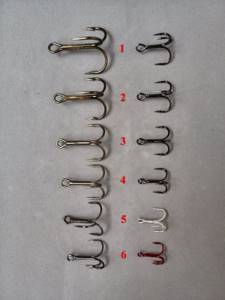
The most used are mandules with the 2nd, 3rd and 4th combination of hooks, less often the 5th and 6th combination, as well as the 1st.
For good fish catching, no less important than the size of the hook is the distance from the body of the bait to the sting of the hook. For the front hook it should be at least 8–10 mm, for the rear hook it should be at least 6–7 mm. And only in small mandules these distances can be somewhat smaller.
For mandules with a single tee, depending on their size, hooks from No. 3 to No. 6–7 are appropriate. In this case, for reliable hooking, I also use models with a shortened forend and a wider hook.
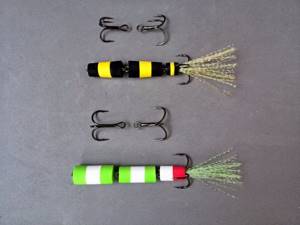
The following photo shows several common hooks used in mandules as the front (from left to right in order of quality improvement - purely personal opinion): Chinese “no name” tee, French VMC 9649, Korean Kumho KH 11030, French VMC 9650, French VMC 8570 , Japanese Gamakatsu treble 13B.
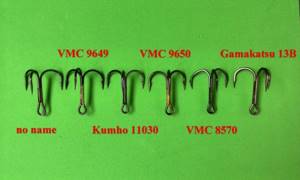
Cheap Chinese tees
, as noted above, I don’t use them, despite the fact that they seem to have a good initial sharpness. But, as experience has shown, they lose it very quickly, in addition, they are not strong enough, especially in small sizes, and even if they are strong, they are made of thick wire. Nevertheless, many anglers quite successfully use Chinese tees, not wanting to overpay for a “company”. This is an entirely personal matter, the choice is yours.
French tees
VMC 9649
are inexpensive hooks, one of the most common, but have a relatively low quality of initial sharpening. One of the positive qualities of these hooks is that, thanks to the geometry of their tip and high-quality wire, they sharpen well and hold repeated sharpening. This feature of hooks is valuable when fishing on rocky ridges, shell rocks, etc., that is, where it is inappropriate to use expensive, sharp hooks that become unusable in such conditions. Quite durable and reliable - very worthy specimens have been lifted on them.
Korean hooks Kumho KH 11030
more expensive than VMC 9649 tees, but also sharper in their original condition. Forged. The sharpening restored on them, in my opinion, is worse than on the aforementioned French ones.
French tees VMC 9650
I was pleasantly surprised by its quality. In terms of price and ability to re-sharpen, they are close to VMC 9649, but in terms of sharpness they surpassed even the Korean ones (at least the ones I had). At its core, VMC 9650 hooks are a reinforced series of VMC 9649 hooks (1x strong). This means that the wire of a VMC 9650 hook, for example, in size No. 1 is the same in thickness as that of a VMC 9649 hook in size 1/0, that is, one size larger. Apparently, the manufacturer took a more careful approach to the quality of sharpening hooks made from thicker wire. The only pity is that VMC 9649 are on every corner, and VMC 9650 cannot be found during the day.
French forged hook VMC 8570 Vanadium
, belonging to the “high” series, made a mixed impression. The quality of the wire and sharpening of the hook is high, however, the same as the price. It is believed that such a hook with an external barb is very responsive to external contacts of the fish with the bait. I couldn’t determine this for sure (maybe I didn’t try hard enough. May fans of these hooks forgive me). But it is very problematic to bring a sting with an external barb into condition after damage. I don’t use them very often; I lean more toward the Japanese Gamakatsu treble 13B tees. The latter are very sharp, forged, hold the initial edge for a long time, and sharpen well. And of course they have a price corresponding to the high Japanese quality.
In general, for more “difficult” places I use mandules with cheaper front French tees, less often Korean ones, for cases when maximum detection is needed - with a front Japanese tee.
The back tee of the mandula is usually on average 4 sizes smaller than the front, and it also needs to cope with the task of reliably hooking and holding the fish if it sets its sights on it, and this often happens. Therefore, I approach the choice of a rear tee, especially if there is only one, very responsibly and most often use hooks from Japanese (in the photo they are in the center), as well as Korean manufacturers (bottom right). I rarely use French hooks in small sizes, but the ones I do use are, for example, vanadium VMC 8540 No. 4, lightweight, quite sharp and durable, but not cheap (pictured on the top right).
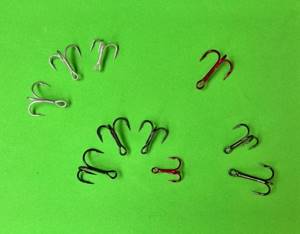
For mandulas with doubles, hooks of size from No. 2/0 to No. 2 are used, for mandulas with singles - hooks No. 1/0, 1, 2, or non-hooking hooks of size from No. 3/0 to 1. Doubles and singles are mainly Japanese and Korean hooks.

Lightweight Japanese doubles with wide hooks Owner TW 01 No. 1/0 and 1 and non-snagging singles Gamakatsu Worm wire guard No. 3/0 performed well.

A minor technical drawback of the TW 01 doubles is that the eye is very wide, while the worm wire guard is, on the contrary, the eye is too small (but it is sufficient for a wire with a diameter of 0.5–0.6 mm). Of course, all these hooks are not a cheap pleasure, but it is worth it. In very “difficult” places I use Korean single-handle-free singles, which are significantly inferior in quality to Gamakatsu non-hooks, but which I don’t mind leaving to the waterman.
Well, for trophy fish - appropriate hooks.
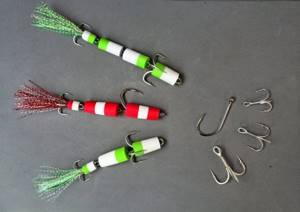
How to make a mandula for fishing?
The bait consists of three moving parts.
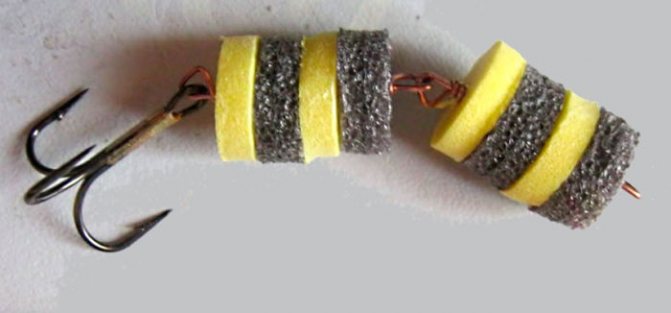
Step-by-step instruction:
- The children's store sells many products made from a special material - polyurethane foam. This material is suitable for our purposes because it is soft, dense and has positive buoyancy. When purchasing a product, it is advisable to think in advance about the future color scheme of the bait. If we do not find a suitable color scheme on sale, then you can achieve the desired color yourself. You need to cut the parts and then glue them into one piece with ordinary glue (moment).
- To facilitate the work and also save time, we will need to make an ordinary tube with a pre-sharpened edge at one end. Next, you need to drill out the finished parts of the composite bait from the glued blank. To do this you need to use a drill, screwdriver or other tool. The resulting parts of the future bait can be combined as we please.
- We empirically select hooks for parts of the bait. So that the metal parts, hooks and frame seem to be pulled out by soft material. For the tail of the tee we will need Lurex. 12–13 fibers of 20 centimeters each is enough. For further work we will need an ordinary drill. You will need to use a drill to drill out the technological channels for the frame. When piercing part of the bait, twist the drill until it begins to turn freely. Next, take any object (scissors or something else) to expand the channels for easier installation.
- To easily insert lurex fibers into the eye of a treble hook , we need a piece of ordinary fishing line. Having bent the fishing line in half, we insert it through the eye of the hook into the resulting loop. Pulling it out from the other side as much as possible. Next, take a bunch of lurex and carefully fold it into two. We put the already folded bundle of lurex into the inserted loop of the fishing line. And, pulling the loop, we pull out one of the sides. Having lowered the loops of the bundle to the hooks of the tee, we need to secure everything tightly. Already in the pre-prepared tail part of the bait. The tail part of the bait is ready.
- Each part must be carefully tried on the hooks and adjusted. Next, we make technological channels in the head and middle parts of the bait. For more precise (controlled) piercing of long parts of the bait, we use any needle.
- To install the frame, you need to use a number 3 guitar string. To make the frame of the mandula, you need to prepare a piece of string. Measuring it so that there is as much allowance as possible. To be able to produce and tighten fastening loops with high quality. To avoid injury, only high-quality and sharp tools should be used for work.
How to make a mandula for catching crucian carp?
Let's look at the features:
- The bait is intended exclusively for jig fishing , which implies almost constant contact with the bottom. This instantly dulls the bait's hooks. And with dull hooks we are doomed to failure. Frequent outcomes or misfires will accompany us throughout the entire fishing period. To avoid this fact, the bait must be positioned vertically in the water.
- Lurex is sold in neatly collected bunches of various colors. Silver works well.
- as the base material .
How to make a mandula with your own hands?
The advantage of making fishing tackle at home is the material that can be used in almost any way (from a rug to old shoes), which is painted in bright colors that imitate live fish.
In Russia, predators do not bite on brightly colored fish, which means the bait must be made in accordance with the preferences of aquatic inhabitants (predators).
The bait has excellent buoyancy due to the lightness of the material. It always remains in sight, since bodies of water must be chosen (preferably) with a clean bottom and clear water.
Making a mandula involves several stages and does not take much time:
- Cut the foam into squares or small bars, paint them in different colors with waterproof paint;
- All protruding ends and corners must be trimmed and rounded, glued together;
- Then, with a heated awl, you need to burn through all the bars from the inside, thereby making passages in them;
- Using a stationery knife, you need to give the bars a symmetrical and aesthetic appearance (this gives a natural look to the product);
- Pass a cotton swab through one bar;
- Take a piece of wire and make a loop at one end, and attach a hook to the other end;
- Using glue and foam blocks, assemble the structure by threading the hook through the block along with the wire, as well as fixing them with loops and glue;
- You need to make a fly from red thread;
- Secure the structure and check for strength;
- The product is ready for use on the pond.
Required tools and materials
The following materials are used to make bait:
- Double or triple hooks;
- Polystyrene foam or polystyrene foam;
- Wire with a diameter of up to 0.8 millimeters;
- Cotton buds;
- Pliers;
- Pliers and tweezers;
- Awl and thick thread;
- Red wool thread;
- Universal waterproof glue;
- Stationery knife.
Fishing with mandula flag
There are different types of mandula. A checkbox is one of the varieties.
The flag mandula is made of polyurethane foam and other materials. Sometimes two materials are combined. The flag is equipped with two hooks, numbers 8 and 12.
Various colors available:
- violet-green;
- White black;
- black-green;
- yellow-red;
- green-red;
- white-yellow.
Any predatory fish will bite the flag mandula. If necessary, can be combined with other baits. She doesn't have her own game.
Edge
To make the edge, you can use various visually attractive materials: shiny New Year's tinsel, colored threads, bright fishing cord (braid), silicone baits (in the form of octopuses, etc.), and of course Lurex and other fly fishing materials. I mainly use Lurex as edging for mandulas; it is very convenient, not expensive, impressive and effective.
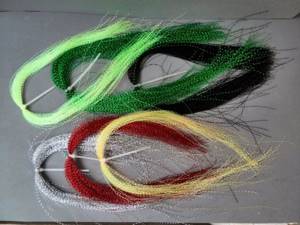
I use several colors: red, light green, green, light yellow, sometimes black, etc. I add silver lurex to all colors, that is, I get a two-color combination, which, in my opinion, is more attractive to fish (I admit a subjective approach here , maybe this is not the case).

There are ambivalent opinions among fishermen regarding the length of the edge: some believe that it is enough for it to protrude beyond the hook hook by only 1–1.5 cm, while others, on the contrary, use long “panicles”, up to 5–6 cm or more. I usually use an edge that protrudes beyond the hook hook by 2.5–3.5 cm, sometimes more. Here you can experiment.
In fishing practice, there are cases when fish are very selective about the size of the bait and prefer very small mandulets - 4 or 5 cm long (not counting the rear tee).

In this case, the body volume is small and the mandula may take a more inclined position than would be desirable or than the fishing conditions require. Increasing the volume of the fixator put on the end tee means reducing the already low clamping capacity of the small tee. A combined edge may be useful here: lurex + EVA strips. This edge has positive buoyancy, is very mobile and responsive to manipulation of the bait. It is very simply made by adding a pair of 1-2 mm strips of thin EVA, which can be purchased at any craft store (foamiran).

You can fix such an edge on a tee with a piece of heat-shrinkable tubing or EVA, but it is better with a bright cambric or a small luminous silicone ball.
To increase the attractiveness of the edge on strips of foamiran, you can draw transverse stripes or dots of different colors on strips of foamiran with a waterproof marker, or you can use foamiran with sparkles. The disadvantage of such a floating combined edge is its fragility. But a silicone ball or cambric allows you to quickly replace a frayed tail; you just need to move them towards the mandula’s body, insert fresh strips of pre-cut material into the eye of the tee and fix them again with a silicone cambric or ball.
This technique can also be used to “straighten” larger mandules. By the way, the entire body of the bait can be formed from strips of foamiran, threading not two strips into each hook, but 8–10 or more...
This is where I end my story, dear fishermen, but fishing experiments continue, while for others they are just beginning or are about to begin. I would like to sincerely wish you creative success and no tail, no scales while fishing.
Fishing with mandula in summer
In the summer, many people take a vacation and go fishing. It is during the summer season that fish are most active. You can use a mandula of any color. But it is necessary to take into account weather conditions and characteristics of the reservoir.
Where can you find fish in the summer?
- the bottom of water holes;
- under steep banks;
- in algae thickets.
In cloudy weather, it is necessary to use baits that have an active game. In the evening and at night you need to use a mandula of dark shades.
In the summer, stepwise wiring with short stops is used. And sometimes they also use direct wiring.
In July, fish are caught with large and medium baits. The fish can be found in the coastal zone as well as in the eddies. In July and August, fish live in places with weak currents.
Fishing with mandula in spring
Active fishing for predators begins in the spring at the beginning of March. At this time, fish attack almost any bait. The best time to fish in spring is morning, evening and night.
In spring, large baits are used. At this time of year, give preference to light shades.
Where to look for fish in spring?
- shallow water areas;
- under steep banks.
In the spring season, hunger begins.
This is the best time to catch these fish:
- pike;
- perch;
- salmon, etc.
Winter fishing for mandula
The best time for fishing in winter is the first ice. In winter, the fish bite slowly and also carefully. Sometimes a bite may not be noticed. Therefore, you need to use a quality whip. You can use a mandula of various colors.
When catching a predator, it is necessary to take into account weather conditions. The fish actively bite during the thaw and in bright sunny weather.
Where can you find fish in the winter season?
- various obstacles;
- stones;
- driftwood;
- deep holes.
Mandula fishing technique
Let's consider fishing techniques in various conditions:
- Fishing from a boat. To increase the time it takes to fall to the bottom, the mandula must be equipped with some kind of light weight. When using such bait, the likelihood of snags will be reduced. But there is one drawback here. When using light weights, the game suffers. If the mandula is equipped with some kind of heavy weight, then it will play perfectly. The body of the bait will create various oscillatory movements. This will attract a predator.
- Shore fishing. The best place for fishing is the coastal edges. This is where the bait reveals its full potential. The cast must be made from the far edge to a greater depth. But shore fishing on the current has a significant drawback. When lifting the mandula, snags occur. To prevent snagging, you need to make sharp jerks.
- Fishing in still water. In still water, the so-called search tactics are used. The fisherman must fish the most promising places. In this case, you need to use active and fast wiring. When fishing in still water, you need to choose the right weight head. Any weight can be used. But it is necessary to take into account the characteristics of the reservoir and weather conditions. When using large weights, the attractiveness of mandula play does not decrease.
Wiring options
To catch a predator, you can use various wiring. In this case, the weight of the load must be taken into account. The lighter the weight of the load, the slower you need to pull out the bait.
When fishing, the following lines are used:
- uneven;
- uniform;
- stepped;
- twitching;
- classical.
Where is the best place to fish?
You can fish both from the shore and from a boat.
Where is the best place to fish?
- reservoir bays;
- under rubble;
- along the banks.
What is a mandula
Mandula is a bait for fishing near the bottom. Its body is usually made of polyurethane foam. The most popular are mandulas whose body consists of 2, 3 or 4 segments. You can also use one-component baits, but their effectiveness is lower.
The mandula also includes several tees, which are connected together with steel wire . The number of hooks usually corresponds to the number of body segments. To make the bait more attractive to pike, you can attach a thread edge to the last hook.
This bait is attached to an eared sinker. Thanks to the presence of the weight, you can make a long cast; in addition, it is necessary to keep the bait in the bottom horizon. You can’t fish with a mandula using equipment without weights, which can bring good results when fishing with silicone.
The mandula has important advantages that make it one of the best lures for pike fishing.
- Polyurethane foam has good buoyancy, so during a pause only the sinker sinks to the bottom, and the bait takes a vertical position. When retrieved, the mandula reminds the pike of a fry collecting food, which will be an easy prey. A vertically standing bait is clearly visible to predators and is an easy target for attack. Due to the fact that the mandula does not sink to the bottom, the chance of getting a bite is maximum.
- The advantage of the mandula is also the presence of two, three or even four open tees . When fishing with this bait, pike are caught very well.
Fishing Features
Let's take a closer look at the fishing features:
- First you need to make a long cast.
- Now you need to wait for the mandula to reach the bottom. And after that, you need to choose a fishing line. In this case, you can release the line several meters.
- You need to pause periodically.
- Most often, the attack occurs when the mandula stops.
On still water
In reservoirs with stagnant water, fish behave in a special way. She doesn't stand still. Fish are always in search of food, which means they constantly move throughout the reservoir.
When fishing in still water, you need to take into account the individual preferences of the fish. One fish prefers to be closer to the bottom, while the other hides in the reeds.
You can use a mandula of various colors and sizes.
Shore fishing on the current
Sometimes large specimens are found along the current. Therefore, when fishing in the current, use a large mandula. And the small fish, on the contrary, avoids the current.
You will need a strong fishing rod and a quality reel. The best place for fishing in the current is the edge of the rapids. The fish sees the bait well during the transition to a smooth stream.
Which mandules are best for pike fishing?
The mandula bait consists of several elements made of polyurethane foam. The elements are connected to each other with winding or ordinary rings. A double or tee is attached to each element. The mandules are loaded with an ordinary eared round weight.
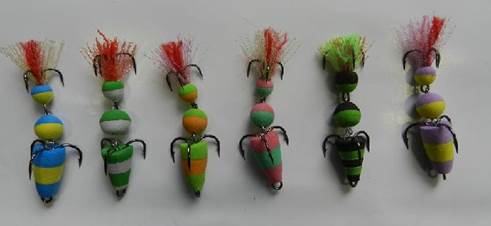
If we talk about mandules for pike fishing, they are larger and consist of two or three segments. The shape of these segments is in the form of a barrel, a truncated cone and a ball. The sizes of tees are usually larger than on pike perch mandules. The most popular sizes of mandules for fishing pike are from 9 to 11 cm.
When catching trophy specimens, mandules up to 15 cm long are used. In general, pike have a large mouth, so you can catch with even larger baits. Mandulas ranging in size from 7 to 9 cm are used in cases where the pike is not hungry or when we know that there are no large or even medium-sized specimens in a given reservoir.
As a rule, mandulas are variegated in color. The most popular colors are combinations of white and black, red and orange, black and yellow, green and pink. The segments are usually solid. But some fishermen make buttons or tablets that they put together and also get good baits.
The photo shows catchable mandules for pike:
We see that there are also threads in the form of tassels attached to the tees. They slow down the fall of the bait and make the game brighter. You can also attach small twisters, vibrating tails or a silicone skirt. In water, such mandules are very noticeable, and pike detect them faster. Many anglers make their own mandules, and they have a great smell from such baits.
As for the weight of weights, balls weighing from 10 to 25 grams are most often used. Casts are made at close and medium distances, up to 40 meters, so there is no particular reason to use heavy weights.
Conclusion
A large number of anglers use mandula to catch various fish. This is a universal bait that has many advantages (simple and reliable design, large selection of colors and modifications, catchability).
Mandula is used by both professional fishermen and amateurs. You can catch fish in almost any conditions.
You can make a mandula yourself or buy it at a fishing store. To make a bait you will need a standard set of tools and inexpensive materials. You can use various fishing techniques and wiring options.
